Day 01 - Delhi to to Aurangabad (By Train & by Flight)
Day 02 - Aurangabad
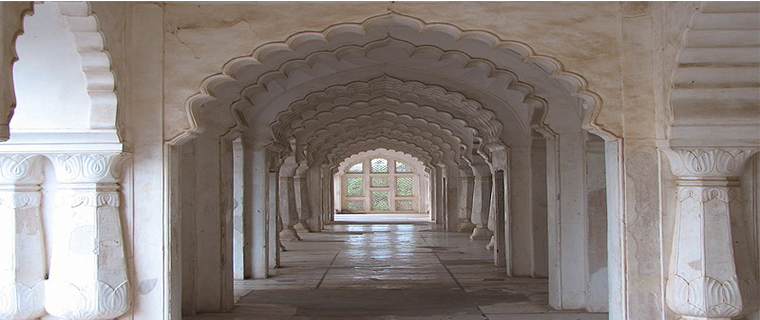 Bibi Ka Maqbara, inside view
Bibi Ka Maqbara, inside view
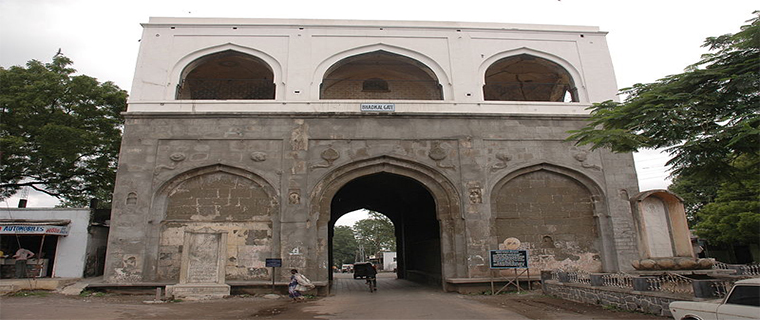 Bhadkal Gate, built by Malik Ambar in commemoration of his victory against the MughalsBibi Ka Maqbara: Situated about 3 km from the city is Bibi Ka Maqbara, the burial place of Aurangzeb's wife, Rabia-ud-Durrani. It is an imitation of the Taj at Agra, and, due to its similar design, it is popularly known as the Mini Taj of the Deccan. TheMaqbara stands in the middle of a spacious and formally planned Mughal garden with axial ponds, fountains, water channels, broad pathways and pavilions. Behind the mausoleum is a small archaeological museum.
Bhadkal Gate, built by Malik Ambar in commemoration of his victory against the MughalsBibi Ka Maqbara: Situated about 3 km from the city is Bibi Ka Maqbara, the burial place of Aurangzeb's wife, Rabia-ud-Durrani. It is an imitation of the Taj at Agra, and, due to its similar design, it is popularly known as the Mini Taj of the Deccan. TheMaqbara stands in the middle of a spacious and formally planned Mughal garden with axial ponds, fountains, water channels, broad pathways and pavilions. Behind the mausoleum is a small archaeological museum.
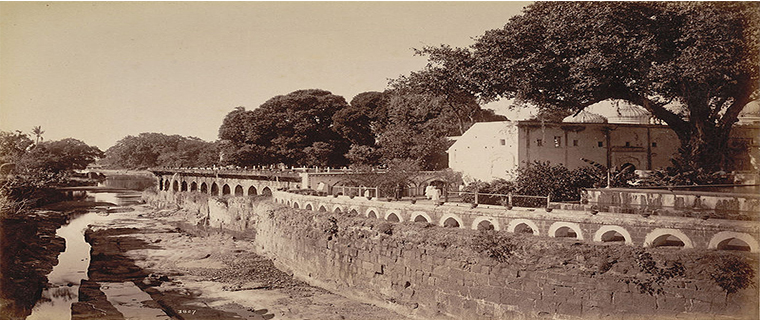 Panchakki, Baba Shah Mosafar Dargah, 1880s
Panchakki, Baba Shah Mosafar Dargah, 1880s
• Panchakki (water mill): Housed in the Dargah complex of Baba Shah Musafir, this is a 17th-century water mill situated at a distance of 1 km from the city. An intriguing water mill, the Panchakki is famous for its underground water channel, which traverses more than 8 km to its source away in the mountains. The channel culminates in a mesmerising artificial waterfall that powers the mill. The beauty of the mosque housed in the inner enclosure is enhanced by a series of 'dancing' water fountains
• Gates in Aurangabad: One of the things that make Aurangabad stand out from the several other medieval cities in India are its 52 'gates', each of which have a local history, or had individuals linked with them. Not many people are aware that Aurangabad is also known as the 'City of Gates'
• Naukhanda palace: This was built by Malik Ambar in 1616 upon the summit of a rising ground at Aurangabad. The massive portal gateway leading to this, over which the Naubatkhana sounded, was called Barkal. The palace had nine apartments. The interior buildings consisted of five zananas, a Divan i Aam, a Divan i Khas, a masjid and a kacheri, each provided with a garden and a cistern.
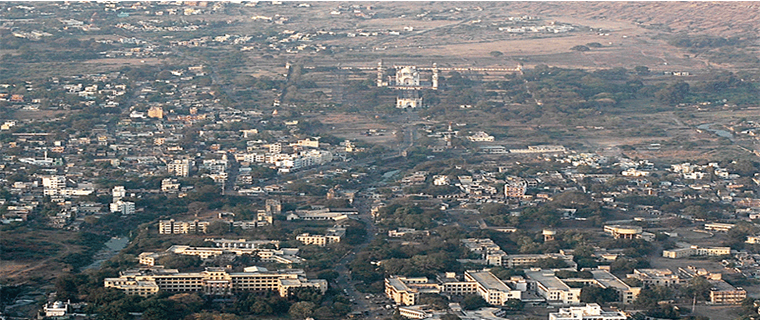 Bibi Ka Maqbara, aerial view
Bibi Ka Maqbara, aerial view
• Himayat Baugh Aurangabad: This is a 17th-century garden that now houses the Fruit Research Station & Nursery, which is a part of the Marathwada Agricultural University. It is located near Delhi Gate in the Rauza Bagh area of Aurangabad. It is a sprawling complex spread over 300 acres (1.2 km2), it is naturally green, and in the olden days it was known as the Mughal garden.[4]
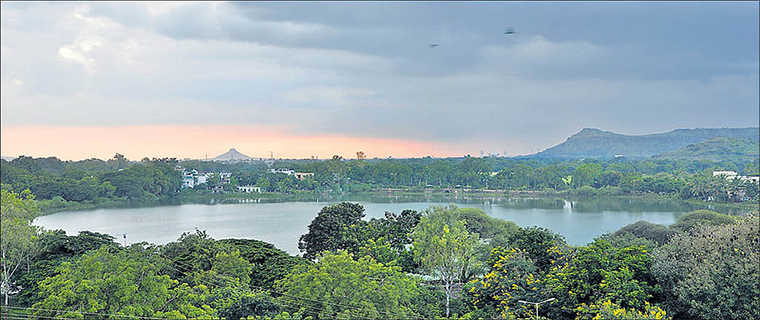 Salim Ali Lake
Salim Ali Lake
• Salim Ali Lake & Bird Sanctuary: Salim Ali Sarovar (lake), popularly known as Salim Ali Talab, is located near Delhi Gate, opposite Himayat Bagh, Aurangabad. It is located in the northern part of the city. During the Mughal period it was known as Khiziri Talab. It was renamed after the great ornithologist and naturalist Salim Ali. It also has a bird sanctuary and a garden maintained by the Aurangabad Municipal Corporation.
• Aurangabad Caves: Situated at a distance of 5 km, nestled amidst the hills are 12 Buddhist caves probably dating back to 3 A.D. Of particular interest are the Tantric influences evident in the iconography and architectural designs of the caves. They also offer a panoramic view of the city as well as the imposing Maqbara.
• Quila-E-Ark: In 1692, Aurangzeb ordered a palace to be built and named it as the Killa Arrak. The space enclosed by the Killa Arrak or citadel covered nearly the whole ground between the Mecca and Delhi gates of the city. It had four or five gateways and a nagarkhana for the musicians. The walls were battle-mented and loop-holed, and had semi-circular towers at the angles, on which guns were once mounted. The inner portion was occupied by recesses similar to those in the city walls. To the right of the entrance was a high terrace extending the whole length of the ground enclosed.
• Kali Masjid, Jama Masjid: Among the mosques, the Jumma Masjid and the Kali Masjid, built by Malik Ambar, and the Shah Ganj mosque, are the most conspicuous. Malik Ambar is said to have built seven mosques which go by the general name of Kali Masjid. The Kali Masjid is in Juna Bazar area and was erected in 1600 A. D. It is a six-pillared stone-building standing on a high plinth. The Jumma Masjid of Malik Ambar is near the Killa Arrak. It has fifty polygonal pillars arranged in five rows, connected by a system of arches, which divide the building into twenty-seven equal compartments, each covered by a domical vault of simple but elegant design. There are nine pointed arches in front. Of these, five were erected by Malik Ambar in 1612 A.D. and the remaining four were added by Aurangzeb.
• Shahganj Masjid: Occupying the great market square of Aurangabad is the large Shah Ganj mosque, one of the finest edifices of its class to be found in any part of India. It was built in about 1720 A.D. Khafi Khan, the author of Muntakhabu-1-Lubab, referring to Sayyad Husain Khan’s viceroyalty of the Deccan (1714–1719) says "the reservoir at Shah Ganj was begun by Sayyad Husain Ali, and although Aazu-d Daula Iraz Khan enlarged and made higher the buildings and mosques, still Sayyad Husain Ali was the originator of that extensive reservoir, which in summer when water is scarce, relieves the sufferings of the inhabitants".
The mosque is on a raised platform, and has shops on three of the outer sides; while the fourth or the north side is open and is ascended by a flight of steps. The facade represents an arcade of five scalloped arches, constructed in the Indo-Saracenic style, and supported on stone pillars. This portion projects a little; and the interior contains twenty-four pillars, which with six pilasters in the back wall, are arranged in the form of a square. The central portion is covered with a graceful bulbous dome, having the base adorned with crisp crinkled lotus leaves tied in a neat narrow band; and the apex bears an elegant spire. Arcaded monasteries called Kham Khas form the east and the west wings, and consist of five arches on either side, constructed like the arches of the main building, but of horizontal structure. The interior is connected by horizontal arches; and the roof is formed of a series of little domes, each supported on four pillars. There are minarets at the corners of the main building, and at the end angels of the Kham Khas. The courtyard in front contains two large cisterns. The entrance is in the form of a little mosque, with a pointed arch and two minarets.
• Chowk Masjid: In 1655 was Chauk Masjid was built by Shayista Khan, the maternal uncle of Aurangzeb. Its front has five pointed arches, and is two arches in depth. These are connected with one another by eight pillars and corresponding pilasters, and support five domes. The central dome, with a metallic spire is lofty, while the others are concealed in the roof. The corners are decorated with minarets. The whole structure has a high basement containing chambers used for shops, which open out on the roadside. The gate has two minarets. There is a cistern in the courtyard in front of the mosque.
• Pir Ismail Mausoleum: Outside the Delhi gate along the Harsul road, in a garden, is a mausoleum to Pir Ismail. Though principally in the Moghul style of architecture, it shows some features common to Pathan architecture. It is said to have been erected in memory of Pir Ismail, a tutor to Prince Aurangzeb. The garden also contains several ruined cisterns and fountains. The gate is rather imposing and has a large pointed archway, forming a sort of portico. The actual entrance is through a small arch at the further extremity. The parapet is nearly ornamented, and so is the facade, which has three small windows with pointed arches, beside recesses. Each corner of the terrace has a little tower surmounted with a bulbous dome and a spire. The mausoleum is square in plan, and has five pointed arches on each side and similar domed towers at the corners. The interior is connected by a system of arches, corresponding with those on the sides and carrying a series of little domes.
• Sunehri Mahal: The Sunehri Mahal in Paharsingpura was erected by a Bundelkhand chief who accompanied Aurangzeb into the Deccan. The building is in stone and lime, and has a high plinth. It is said to have derived its name from the paintings of gold which at one time decorated it.
Day 03 - Aurangabad to Ellora to Aurangabad (110 KM 2 HRS. )
Ajanta Caves: The Ajanta Caves in Maharashtra, India are 31 rock-cut cave monuments which date from the 2nd century BC. The caves include paintings and sculptures considered to be masterpieces of both Buddhist religious art (which depict the Jataka tales)[5] as well as frescos which are reminiscent of the Sigiriya paintings in Sri Lanka.[6]
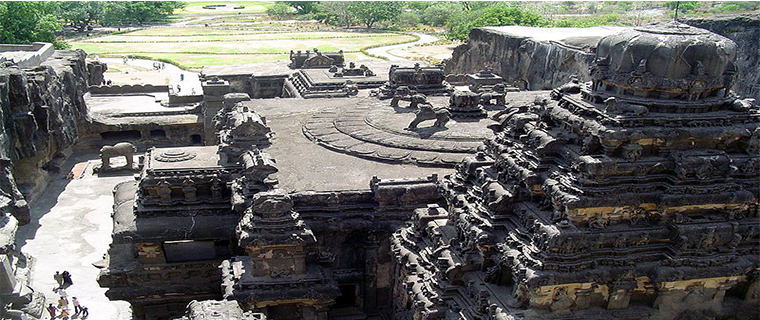 Kailasha temple at Ellora
Kailasha temple at Ellora
• Ellora Caves: Ellora is an archaeological site, 30 km (19 mi) built by the Rashtrakutarulers. Well known for its monumental caves, Ellora is a World Heritage Site.[7] Ellora represents the epitome of Indian rock-cut architecture. The 34 "caves"&ndash, actually structures excavated out of the vertical face of the Charanandri hills, beingBuddhist, Hindu and Jain rock-cut temples and monasteries, were built between the 5th and 10th centuries.
Day 04 - Ajanta to Buhranpur (250 KM 5 Hrs.Approx )
Burhanpur was an important city under Rashtrakuta Dynasty during 753–982. During excavations in Tapti River & Asirgarh Fort many coins, goddess idols and temples discovered which belongs to prehistoric era. But, Burhanpur got its name and fame during medieval time.
In 1388, Malik Nasir Khan, the Faruqi dynasty Sultan of Khandeshdiscovered Burhanpur, at the behest of Shaikh Zainuddin and renamed it after a well-known medieval sufisaint, Burhan-ud-Din. Burhanpur became the capital of the Khandeshsultanate. Later, Miran Adil Khan II (reigned 1457–1501), another sultan of this dynasty built a citadel and a number of palaces in Burhanpur.[1]During his long reign, Burhanpur was transformed into a major centre for trade and textile production. In 1601, Mughal emperor Akbar annexed the Khandesh sultanate and Burhanpur became the capital of Khandesh Subah of the Mughal empire.[2] In 1609 Jahangir appointed his second son Parvizto the governorship of the Mughal provinces of the Deccan, and the prince chose Burhanpur as his headquarters as his residence.
 Royal bath or hammam Shahi qila Burhanpur
Royal bath or hammam Shahi qila Burhanpur
It is a beautiful city with a lot of historical monuments existing in its expanse, primarily from the ruling times of Shah Jahan, the great Mughal emperor. Burhanpur was an important outpost of the Mughals. Shah Jahan spent a considerable time in this city, and helped add to the Shahi Qila. The Shahi Qila is one majestic palace in Burhanpur, located to the east of the Tapti River. Diwan-i-Aam and Diwan-i-Khas were built on the terrace of the Qila. Little of it remains today as the Qila is mostly in ruins now. However, the parts of the Palace that still stands displays amazing works of sculpture and exquisite carvings. The main attraction at the palace is the hamam or the royal bath. It was specifically built for Shah Jahan's wife, Begum Mumtaz Mahal, so that she could enjoy a luxurious bath. It is said that she died here giving birth to her fourteenth child. Even today, the ceiling has many intricate paintings. One of these paintings depicts a monument which is said to have been the inspiration for the Taj Mahal.[
Day 05 - Buhranpur to Mandu Via Omkareshwar (280 KM 6 Hrs.Approx )
Omkareshwar (Hindi: ओंकारेश्वर Ōṃkārēśvar) is a Hindu temple dedicated to God Shiva. It is one of the 12 revered Jyotirlinga shrines of Shiva.[1] It is on an island called Mandhata or Shivapuri in the Narmada river; the shape of the island is said to be like the Hindu ॐ symbol.
There are two main temples of Lord Shiva here, one to Omkareshwar (whose name means "Lord of Omkaara or the Lord of the Om Sound") located in the island and one to Amareshwar (whose name means "Immortal lord" or "lord of the Immortals or Devas") located on the south bank of Narmada River on the mainland.[2] As per the sloka on dwadash jyotirligam, Mamleshwar the other name of Amareshwar is the jyotirling, nonetheless, many consider both Omkareshwar and Mamleshwar equally sacred and representative of jyotirling at this sacred place.
---------------------------------------------------------------------------------------------------
Also refer to Places of interest in Mandav
Mandu, due to its strategic position and natural defences, was an important place with a rich and varied history. It was an important military outpost and its military past can be gauged by the circuit of the battlemented wall, which is nearly 37 km (23 mi) and is punctuated by 12 gateways. The wall encloses a large number of palaces, mosques, Jain temples of 14th century and other buildings. The oldest mosque dates from 1405; the finest is the Jama Masjid or great mosque, a notable example of Pashtun architecture. The marble domed tomb of this ruler is also magnificent
Some of the notable places, listed in South to North direction are:
Roopmati's Pavilion
A large sandstone structure originally built as an army observation post it is known today as Roopmati's Pavilion. Rani Roopmati - the love interest of Baaz Bahadur lived here and is said to have gazed at the Baz Bahadur's Palace - situated below and also at Narmada river, flowing through the Nimar plains far below, a river which the queen revered.
 Roopmati's Pavilion
Roopmati's Pavilion
 Roopmati's Pavilion
Roopmati's Pavilion
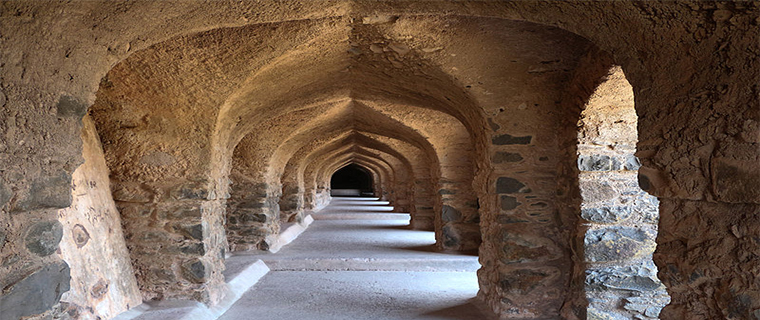 Inside the Roopmati's PavilionBaz Bahadur's Palace
Inside the Roopmati's PavilionBaz Bahadur's Palace
Built by Baz Bahadur, this 16th-century structure is famous for its large courtyards encompassed by large halls and high terraces. It is situated below Roopmati's Pavilion and can be seen from the pavilion.
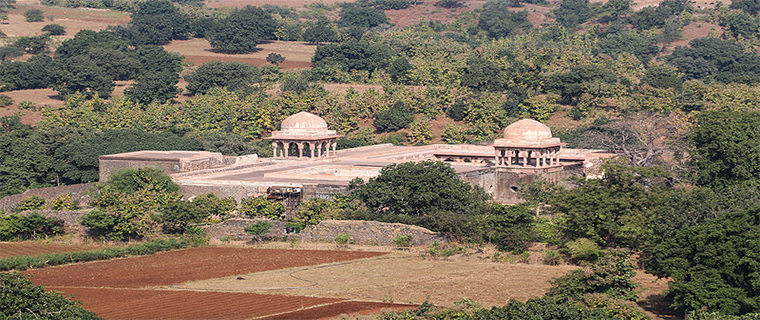 Baz Bahadur's Palace seen from Roopmati's Pavilion
Baz Bahadur's Palace seen from Roopmati's Pavilion
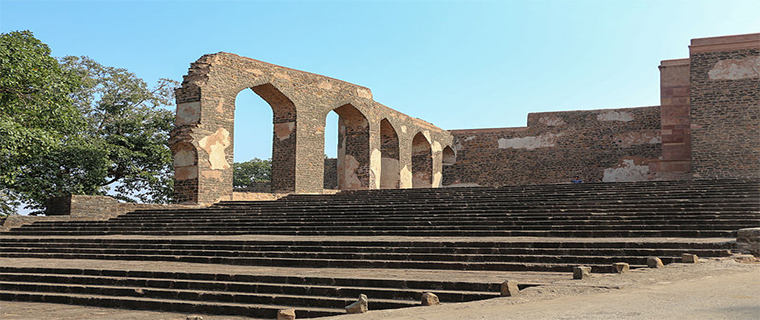 Entrance to the Palace
Entrance to the Palace
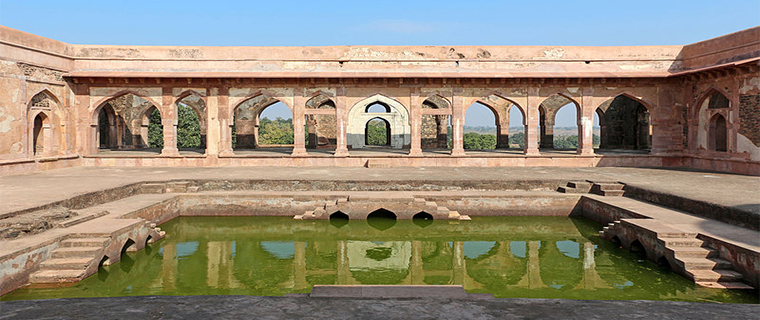 Main court of the Palace
Main court of the Palace
Rewa Kund
A reservoir constructed by Baz Bahadur for the purpose of supplying water to Rani Roopmati's Pavilion. The reservoir is situated below the pavilion and hence is considered an architectural marvel.
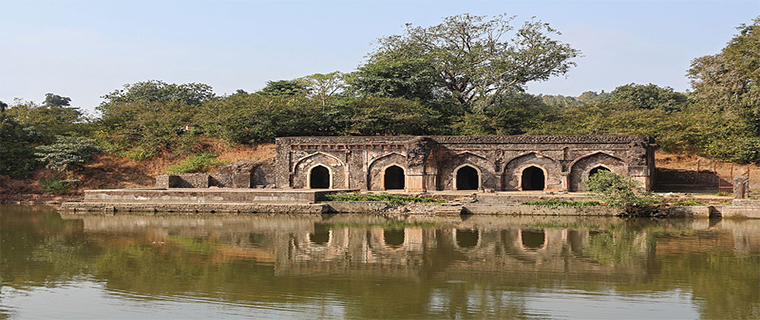 Rewa Kund - a reservoir that supplies water to Roopmati's Pavilion
Rewa Kund - a reservoir that supplies water to Roopmati's Pavilion
Eco point
Malik Mughith tomb
Darya Khan's Tomb complex
Darya Khan was a minister in the court of Mahmud Khalji II, and his tomb lies in a walled complex along with another tomb, a mosque, a pond and an inn. At the centre of the complex is the massive sand stone tomb of Darya Khan. Hathi Paga Mahalor Elephant Leg Palace is located on the south-eastern side of the Darya Khan Complex, and is crowned with a massive dome.
Shri Mandavagadh Teerth
Shri Mandavagadh Teerth is dedicated to Lord Suparshvanatha. It belongs to Shwetambar Sect of Jainism. The temple has been attractively constructed and looks exquisite. It underwent expansion in 14th century. The idol of Lord Suparshvanath is believed to be much older. The idol is white in complexion and is 91.54 cm (3 feet) in height. It is seated in a padmansana posture. Apart from this in this same fort there is a fine temple of smaller size of Lord Shantinath. Ruins of many temples and idols can be seen here. As per a reference once there were almost 700 Jain temples here. [12]
Sharif Shaikh Abdulla Shattari Dargah
Jami Masjid Inspired by the great mosque of Damascus, this enormous structure is striking in both its simplicity and architectural style-with large courtyards and grand entrances. At the front of Jaami Mosque, there are ruins of Asharfi Palace. There is a seven story winning memorial at the north-east of the Palace, and also a fascinating Ram Temple nearby, which was built by Maharani Sakarwar bai pawar in 1769 AD.
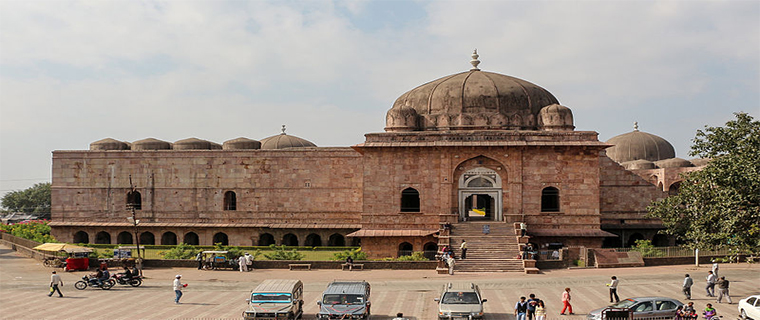 The entrance
The entrance
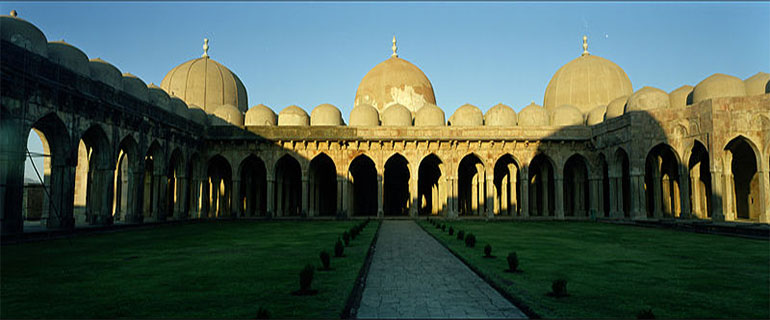 The courtyard
The courtyard
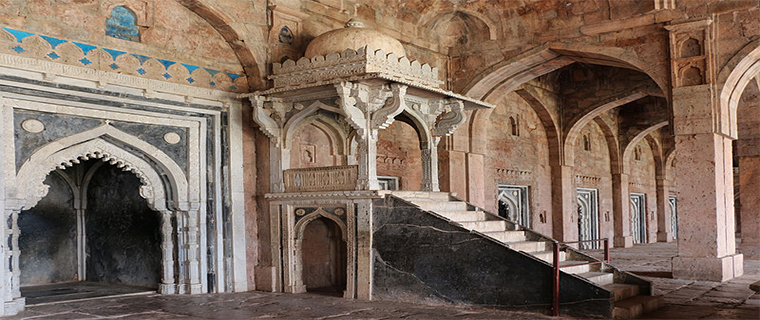 The minbar
The minbar
Day 07 - Mandu to Bhopal via Ujjain (330 KM 6 Hrs.Approx )
Excavations at Kayatha (around 26 km from Ujjain) have revealedchalcolithic agricultural settlements dating to around 2000 BCE.[4]Chalcolithic sites have also been discovered at other areas around Ujjain, including Nagda, but excavations at Ujjain itself have not revealed any chalcolithic settlements. H. D. Sankalia theorized that the chalcolithic settlements at Ujjain were probably destroyed by the Iron Age settlers.[5]
According to Hermann Kulke and Dietmar Rothermund, Avanti, whose capital was Ujjain, "was one of the earliest outposts in central India" and showed signs of early urbanisation around 700 BCE.[6] Around 600 BCE, Ujjain emerged as the political, commercial and cultural centre of Malwaplateau.[7]
The ancient walled city of Ujjain was located around the Garh Kalika hill on the bank of river Kshipra, in the present-day suburban areas of the Ujjain city. This city covered an irregular pentagonal area of 0.875 km2. It was surrounded by a 12 m high mud rampart. The archaeological investigations have also indicated the presence of a 45 m wide and 6.6 m deep moat around the city.[8] According to F. R. Allchin and George Erdosy, these city defences were constructed between 6th and 4th centuries BCE.[9] Dieter Schlingloff believes that these were built before 600 BCE.[8] This period is characterised by structures made of stone and burnt-brick, tools and weapons made of iron, and black and red burnished ware.[9]
According to the Puranic texts, a branch of the legendary Haihaya dynasty ruled over Ujjain.[10][11]
In the Mauryan period, Ujjain remained the administrative centre of the region. From this period, Northern Black Polished Ware, copper coins, terracotta ring wells and ivory seals with Brahmi text have been excavated.[9] During the reign of his father Bindusara, Ashoka served as the viceroy of Ujjain.[12] Ujjain was subsequently controlled by a number of empires and dynasties, including the Shungas, the Western Satraps, the Satavahanas, the Guptas and the Paramara. The Paramaras shifted the region's capital from Ujjain to Dhar.[7]
Ujjain was an important literary centre of ancient India, called Adyapeetha, or foundation of Sanskrit learning, ethics, knowledge, science and art, and has been called, "Swarna Sringa", in local parlance, due to the golden towers of the many temples in this temple city.[13] Raja Bharthari wrote his great epics, Virat Katha, Neeti Sataka, the love story of Pradyot Princess Vasavadatta and Udayan in Ujjayini, as the city was called during his times. The writings of Bhasa are set in Ujjain, and he probably lived in the city.[14] Kalidasa also refers to Ujjain multiple times, and it appears that he spent at least a part of his life in Ujjain.[15] Mrichchhakatika by Shudraka is also set in Ujjain.[16] Ujjain also appears in several stories as the capital of the legendary emperor Vikramaditya. Somadeva's Kathasaritsagara (11th century) mentions that the city was created by Vishwakarma, and describes it as invincible, prosperous and full of wonderful sights.[17]
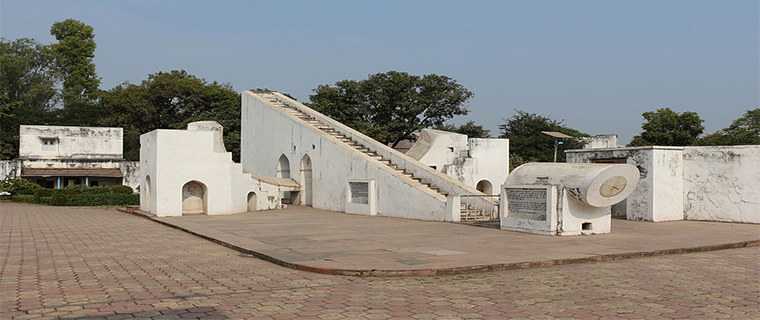 The Jantar Mantar at Ujjain was commissioned by Jai Singh II (1688-1743) of Jaipur
The Jantar Mantar at Ujjain was commissioned by Jai Singh II (1688-1743) of Jaipur
During medieval times, Ujjain ultimately came under the Islamic rule, like other parts of north-central India. In 1235 CE, Iltutmish of Delhi Sultanate plundered the city, and destroyed its temples.[7] However, Ujjain continued to be an important city of the region. As late as during the times of the Mughal vassal Jai Singh II (1688-1743), who constructed a Jantar Mantar in the city, Ujjain was the largest city and capital of the Malwa Subah.[18]
During the 18th century, the city briefly became the capital of Scindia state of theMaratha confederacy, when Ranoji Scindia established his capital at Ujjain in 1731. But his successors moved to Gwalior, where they ruled the Gwalior State in the latter half of the 18th century. The struggle of supremacy between the Holkars of Indoreand Scindias (who ruled Ujjain) led to rivalry between the merchants of the two cities.[19] On 18 July 1801, the Holkars defeated the Scindias at the Battle of Ujjain. On 1 September, Yashwantrao Holkarentered the city, and demanded a sum of 15 lakh rupees from the city. He received only 1/8th of this amount; the rest was pocketed by his officers. A force sent by Daulat Scindhia later regained control of Ujjain.[20] After both Holkar and Scindias accepted the British suzerainty, the British colonial administrators decided to develop Indore as an alternative to Ujjain, because the merchants of Ujjain had supported certain anti-British people. John Malcolm, the British administrator of Central India, decided to reduce the importance of Ujjain "by transferring a great part of that consequence it now enjoys to the Towns of Indore and Rutlam cities, which are and will continue more under our control."[19]
After the independence India, Ujjain became a part of the Madhya Bharat state. In 1956 Madhya Bharat was fused into the State of Madhya Pradesh.
Day 06 - Bhopal - Bhimbetka -Bhojpur - Bhopal ( ( 90 KM 2Hrs.Approx )
Early history[edit]
According to folklore, Bhopal was founded in 11th century by the Paramaraking Bhoja, who ruled from his capital at Dhar. This theory states that Bhopal was originally known as Bhojpal after a dam (pal) constructed by the king's minister.[1] No archaeological evidence, inscriptions or historical texts support the claim about an earlier settlement founded by Bhoja at the same place, although the Bhojeshwar Temple ascribed to him exists at Bhojpur, which is 28 km from Bhopal. An alternative theory says that the city is named after another king called Bhupala (or Bhupal).[12][13][14]
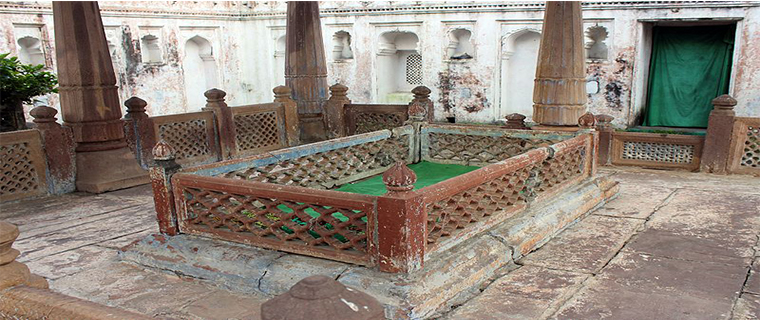 Mausoleum of Dost Khan founder of Bhopal state
Mausoleum of Dost Khan founder of Bhopal state
In the early 18th century, Bhopal was a small village in the Gond kingdom. The modern Bhopal city was established by Dost Mohammad Khan (1672–1728), anAfghan soldier in the Mughal army.[15] After the death of the emperor Aurangzeb, Khan started providing mercenary services to local chieftains in the politically unstable Malwa region. In 1709, he took on the lease of Berasia estate and later annexed several territories in the region to establish the Bhopal State.[16] Khan received the territory of Bhopal from the Gond queen Kamlapati in lieu of payment for mercenary services and usurped her kingdom after her death.[17] In the 1720s, he built the Fatehgarh fort in the village, which developed into the city of Bhopal over the next few decades.
Begum rule
Bhopal became a princely state after signing a treaty with the British East India Company in 1818.[18] Between 1819 and 1926, the state was ruled by four women, Begums — unique in the royalty of those days — under British suzerainty. Qudsia Begum was the first woman ruler, who was succeeded by her only daughter Sikandar Begum, who in turn was succeeded by her only daughter, Shahjehan Begum. Sultan Jahan Begum was the last woman ruler who, after 25 years of rule, abdicated in favour of her son, Hamidullah Khan. The rule of Begums gave the city its waterworks, railways, a postal system, and a municipality constituted in 1907.[19]
The Buddhist vihara at Sanchi, famous for its Great Stupa is located at Sanchi Town in Raisen District of the state of Madhya Pradesh, India, it is 46 km north-east of Bhopal.
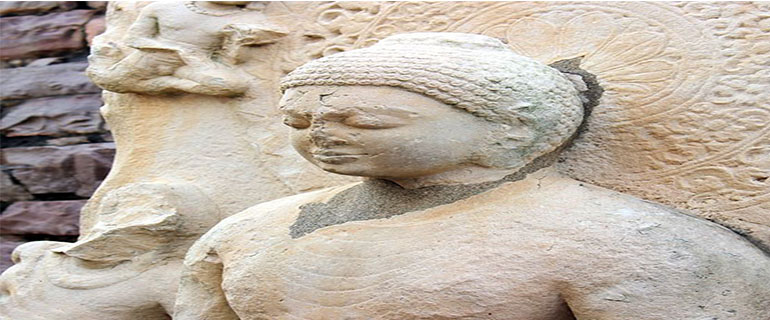 Statue of Lord Buddha seen at the main entrance of Great Sanchi Stupa
Statue of Lord Buddha seen at the main entrance of Great Sanchi Stupa
The Great Stupa at Sanchi is the oldest stone structure in India[1] and was originally commissioned by the emperor Ashoka the Great in the 3rd century BCE. Its nucleus was a simple hemispherical brick structure built over the relics of the Buddha. It was crowned by the chatra, a parasol-like structure symbolising high rank, which was intended to honour and shelter the relics. The construction work of this stupa was overseen by Ashoka's wife, Devi herself, who was the daughter of a merchant of Vidisha. Sanchi was also her birthplace as well as the venue of her and Ashoka's wedding. In the 1st century BCE, four elaborately carved toranas (ornamental gateways) and a balustrade encircling the entire structure were added. The sanchi stupa built during Mauryan period was made of bricks
Day 07 - Bhopal - Orchha Via Sanchi (330KM 7 Hrs.Approx )
Day 08 - Orchha - Khajuraho (190 KM 4 Hrs.Approx )
On a seasonal island on the bank of the Betwa River, which has been surrounded by a battlement wall, stands a huge palace-fort. The fort consists of several connected buildings erected at different times, the most noteworthy of which is the Raja Mahal.
The Ram Raja Temple is built on a square base and has an almost entirely plain exterior, relieved by projecting windows and a line of delicate domes along the summit. The Jahangir Mahal is built on a rectangular base and is relieved by a circular tower at each corner surmounted by a dome, while two lines of graceful balconies supported on brackets mark the central storeys. The roof is crowned by eight large fluted domes, with smaller domes between them, connected by an ornamental balustrade. The Jahangir Mahal is considered to be a singularly beautiful specimen of Mughal architecture. A point worth mentioning here is that the mother for Jahangir was also a Rajput, Jodha. It is with this in mind that the Rajput king of Orchha had built the Jahangir Mahal.[8] Chaturbhuj Temple is an old temple from the 9th century.
The Uth Khana (Camel Shelter) where the King's camels were stationed is right next to the fort and is a must-see. Tourists can also climb on the roof of the Uth Khana and get a fantastic view of Orchha town. The ruins behind the fort complex are an even greater sight. It makes a tourist travel back in time and is an integral part of a visit to Orchha. It houses the residences of various military officers, ministers (housing, roads), gunpowder factory, etc. Although most are in absolute ruins, a silent walk through the ruins can give one goosebumps.
Numerous cenotaphs or chhatris dot the vicinity of the fort and the Betwa river. Elsewhere about the town there is an unusual variety of temples and tombs, including the Chaturbhuj temple, which is built on a vast platform of stone. The more unguarded and neglected of these buildings are popular hangouts for tropical bees, wasps, and other such excitable stinging creatures.
In 2006, Orchha's buildings were being documented by the LIK Team of IIT Roorkee, India[9]
A community radio station, Radio Bundelkhand was launched in Orchha on October 23, 2008. It is an initiative of theDevelopment Alternatives Group. The radio station broadcasts daily programs in the Bundeli dialect and devotes significant amount of its broadcast time to local issues, culture, education and the rich tradition of Bundeli folk music. The station is available on 90.4 MHz.
Day 09 - Khajuraho
The Khajuraho group of monuments was built during the rule of the Rajput Chandela dynasty. The building activity started almost immediately after the rise of their power, throughout their kingdom to be later known as Bundelkhand.[9] Most temples were built during the reigns of the Hindu kings Yashovarman and Dhanga. Yashovarman's legacy is best exhibited by The Lakshmana Temple. Vishvanatha temple best highlights King Dhanga's reign.[10]:22 The largest and currently most famous surviving temple is Kandariya Mahadeva built in the reign of King Ganda from 1017-1029 CE.[2] The temple inscriptions suggest many of the currently surviving temples were complete between 970 and 1030 CE, with further temples completed during the following decades.[6]
The Khajuraho temples were built about 35 miles from the medieval city of Mahoba,[11] the capital of the Chandela dynasty, in the Kalinjar region. In ancient and medieval literature, their kingdom has been referred to as Jijhoti, Jejahoti, Chih-chi-to and Jejakabhukti.[12]
Khajuraho was mentioned by Abu Rihan-al-Biruni, the Persian historian who accompanied Mahmud of Ghazni in his raid of Kalinjar in 1022 CE; he mentions Khajuraho as the capital of Jajahuti.[13] The raid was unsuccessful, and a peace accord was reached when the Hindu king agreed to pay a ransom to Mahmud of Ghazni to end the attack and leave.[12]
Khajuraho temples were in active use through the end of 12th century. This changed in the 13th century, after the army of Delhi Sultanate, under the command of the Muslim Sultan Qutb-ud-din Aibak, attacked and seized the Chandela kingdom. About a century later, Ibn Battuta, the Moroccan traveller in his memoirs about his stay in India from 1335 to 1342 CE, mentioned visiting Khajuraho temples, calling them “Kajarra”[14][15] as follows:
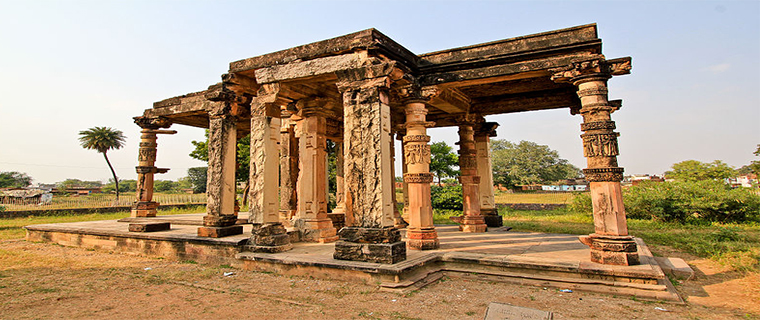
Until the 12th century, Khajuraho was under Hindu kings and featured 85 temples. Central India was seized by Delhi Sultanate in 13th century. Under Muslim rule, some temples were destroyed and the rest left in neglect. Ruins of some old temples (above) are still visible.
...near (Khajuraho) temples, which contain idols that have been mutilated by the Moslems, live a number of yogis whose matted locks have grown as long as their bodies. And on account of extreme asceticism they are all yellow in colour. Many Moslems attend these men in order to take lessons (yoga) from them.
Ibn Battuta, about 1335 CE, Riḥlat Ibn Baṭūṭah, Translated by Arthur Cotterell[16]
Central Indian region, where Khajuraho temples are, remained in the control of many different Muslim dynasties from 13th century through the 18th century. In this period, some temples were desecrated, followed by a long period when they were left in neglect.[6][9] In 1495 CE, for example, Sikandar Lodi’s campaign of temple destruction included Khajuraho.[17] The remoteness and isolation of Khajuraho protected the Hindu and Jain temples from continued destruction by Muslims.[18][19]Over the centuries, vegetation and forests overgrew, took over the temples.
In the 1830s, local Hindus guided a British surveyor, T.S. Burt, to the temples and they were thus rediscovered by the global audience.[20] Alexander Cunningham later reported, few years after the rediscovery, that the temples were secretly in use by yogis and thousands of Hindus would arrive for pilgrimage during Shivaratri celebrated annually in February or March based on a lunar calendar. In 1852, Maisey prepared earliest drawings of the Khajuraho temples.[21]
Day 10 - Khajuraho - Allahabad via Chitrakoot (295 KM 5 Hrs.Approx )
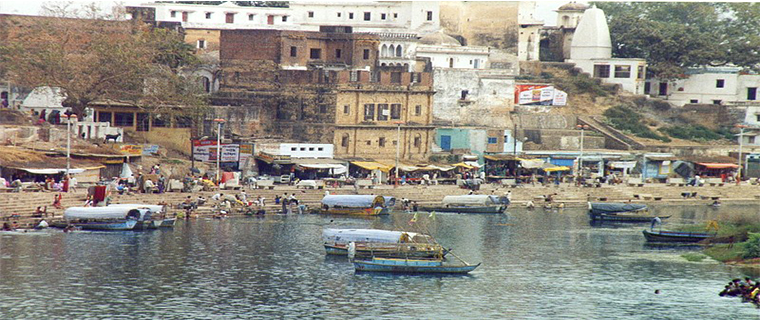 View of Ramghat
View of Ramghat
Ramghat
The ghats that line the Mandakini river are called Ramghat. During the exile period Rama, Lakshmana and Sita took bath here and are believed to have appeared before the poet Tulsidas.
Kamadgiri
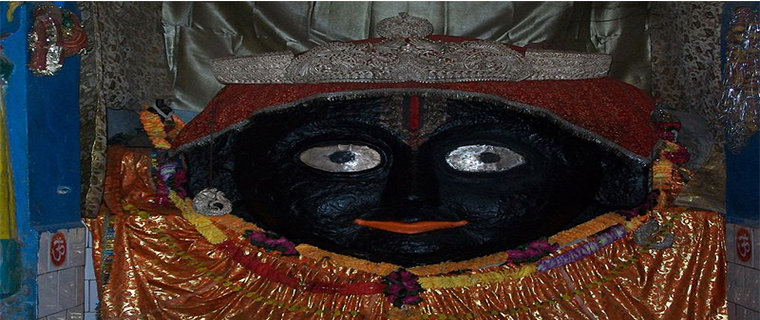 Shri Kamta Nath 2nd face on Kamadgiri parikrma path
Shri Kamta Nath 2nd face on Kamadgiri parikrma path
Kamadgiri, the original Chitrakuta, is a place of prime religious significance. A forested hill, it is skirted all along its base by a chain of temples and is venerated today as the holy embodiment of Rama. Lord Rama is also known as Kamadnathji which literally means fulfiller of all wishes. There is a 5 km Parikrama Path around the Kamadgiri Mountain.
Bharat Milap
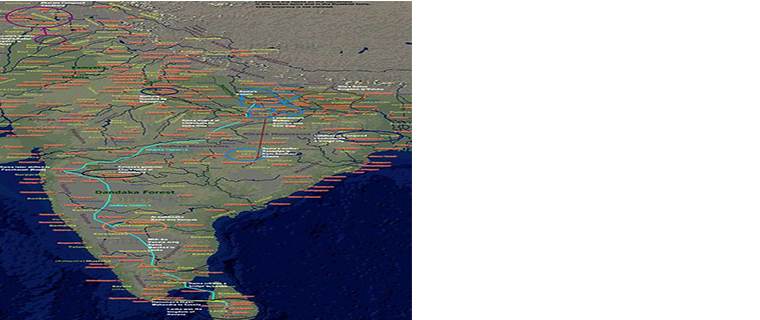 Places Related to Ramayana, showing Chitrakuta in Rama's journey from Ayodhya to Lanka.
Places Related to Ramayana, showing Chitrakuta in Rama's journey from Ayodhya to Lanka.
Bharat Milap temple is located here, marking the spot where Bharata is said to have met Rama to persuade him to return to the throne of Ayodhya. It is said that the meeting of four brothers was so emotional that even the rocks and mountains of Chitrakut melted. Foot prints of Lord Rama and his brothers were imprinted on these rocks and are still present today and seen in Bharat Milap Mandir. Bharat milap mandir is situated beside kamadgiri mountain, in the circumbulation path of kamadgiri.
Janaki Kund[
Janaki Kund is situated upstream of the Ramghat where it is believed that Sita bathed in the crystal clear waters of Mandakini river during the years of her exile with Rama.
Sati Anasuya ashrama
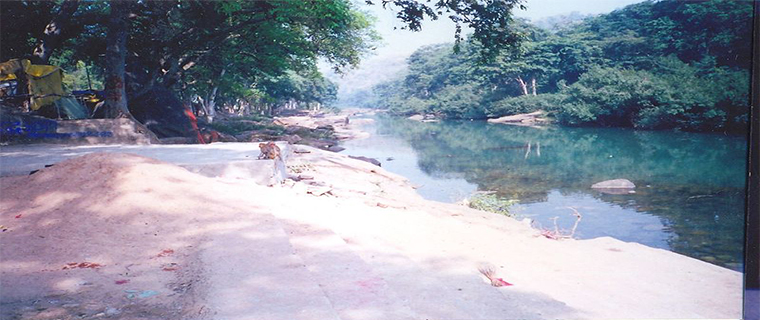 View of Mandakini River at Anusuya ashram
View of Mandakini River at Anusuya ashram
Sati Anasuya ashrama is located further upstream, 16 km from the town, set amidst thick forests that round to the melody of birdsong all day. It was here that Atri muni, his wife Anasuya and their three sons (who were the three incarnations of Brahma, Vishnu and Mahesh), lived and are said to have meditated.
As per description of Valmiki at one time there was no rain in Chitrakuta for ten years. There was a severe famine and nothing was left to eat or drink for animals and birds. Sati Anasuya performed hard and intensive austerities and got the river Mandakini down on earth. This led to the greenery and forests to grow which removed the sufferings of all sages and the animals.[4]
Sati Anasuya ashrama at present is a very peaceful place where various streams from the hills converge and form the Mandakini River. It is said that Rama along with Sita had visited this place to meet Maharishi Atri and Sati Anasuya. It is here Sati Anasuya explained to Sita the grandeur and importance of satitva. The dense forests of Dandaka start from this place. It was ruled by Ravana. Ravana had appointed strong rakshasas like Khara and Viradha as its rulers. The place was infected by the terror of rakshasas.[5]
Sphatic Shila
A few kilometres beyond Janaki Kund is another densely forested area on the banks of the Mandakini. One can climb up to the boulder, which bears the Rama's footprint and Sita. According to Ramacharit Manas it is said that Lord Rama with Lakshman was sitting on this shila (rock) when Hanuman returned from Lanka after setting it afire and confirmed the news to Lord Rama that Sita has been imprisoned in Ashoka vatika at Lanka.
Gupt-Godavari[
Gupt-Godavari is situated at a distance of 18 km from town. Here is a pair of caves, one high and wide with an entrance through which one can barely pass, and the other long and narrow with stream of water running along its base. It is believed that Rama and Lakshmana held court in latter cave, which has two natural throne-like rocks.
Pampapur
It is situated in the valley of Devangana. Here we find sacred caves. Sacred caves related to Lord Rama.
Hanuman Dhara
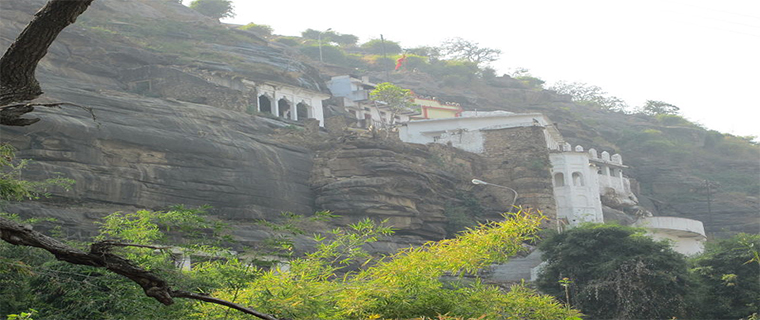 Temples in Panchmukhi Hanuman Dhara
Temples in Panchmukhi Hanuman Dhara
Located on a rock-face several hundred feet up a steep hillside is a spring, said to have been created by Rama to assuage Hanuman when the latter returned after setting Lanka afire. A couple of temples commemorate this spot, which offers a panoramic view of Chitrakut.
Bharat Koop[
Bharath Koop is where Bharata stored holy water collected from all the places of pilgrimage in India. It is small, an isolated spot a few kilometres from the town. It has a small well and temple situated next to it. The water in the well remains pure and clean round the year. The story goes, that Bharatji came to Chitrakoot to convince Shri Ram to come back to Ayodhya, after the death of King Dasharath, to ask Shri Ram to become king of Ayodhya and rule it, thus creating Ram-Rajya. For this purpose, he also bought the waters of five rivers along with him to do Lord Shri Ram's coronation. But, Lord Ram told Bharath that he does not wish to break his vow given to King Dasharath of coming back to Ayodhya only after completing Vanvas of 14 years. Hence, Bharath asked rishi Vashisht how to use the 5 rivers water that he brought along with him for Lord Ram's Rajya Abhishek. Rishi Vashisht advised him to put all the water along with flowers he had got for Rajya-abhishek in a well specified near Chitrakoot. He explained that the water in this well will remain pure and will be revered till the end of the time. Hence, upon the advice of rishi Vashisht, king Bharath followed his instructions and thus this place was named as Bharath koop.
Ram Shaiya
This place is located on the way between Chitrakoot and Bharat Koop, in an isolated location. It is the place where Shri Ram, Sitaji and Laxmanji used to sleep and rest in the evening after wandering around the forest of Chitrakoot. It is located between mountains with no town near-by, with absoluted silence in the environment. It has a large flat-bed rock which bears imprints of Shri Rama, Lakshman, and Sita Mata. There is a tree above it and the entire place is walled by brick structure on the sides to preserve it. It falls in the state of Uttar Pradesh.
Day 11 - Allahabad - Varanasi (130 KM 3 Hrs.Approx )
Allahabad's elevation is over 90 m (295 ft) above sea level. The old part of the city, at the south of Allahabad Junction Railway Station, consists of neighbourhoods like Chowk, Johnstongunj, Dariyabad, Khuldabad and many more.[64] In the north of the Railway Station, the new city consists of neighbourhoods like Lukergunj, Civil Lines, Georgetown, Tagoretown, Allahpur, Ashok Nagar, Mumfordgunj, Bharadwaj Puram and others which are relatively new and were built during the British rule.[65] Civil Linesis the central business district of the city and is famous for its urban setting, gridiron plan roads[66] and high rise buildings. Built in 1857, it was the largest town-planning project carried out in India before the establishment of New Delhi.[65][66] Allahabad has many buildings featuring Indo-Islamic and Indo-Saracenic architecture. Although several buildings from the colonial period have been declared "heritage structures", others are deteriorating.[67] Famous landmarks of the city are Allahabad Museum, New Yamuna Bridge, Allahabad University, Triveni Sangam, All Saints Cathedral, Anand Bhavan, Alfred Parketc.[68]
Ghats[The main ghat in Allahabad is Saraswati Ghat, located on the banks of Yamuna. It is a newly built delightful place. Stairs from three sides descend to the green water of the Yamuna. And above there is a park which is always covered with green grass. There are also facilities for boting here. There are also routes to reach Sangam by boat from here.[69][70]
Sangam GhatBalua GhatRasulabad GhatShee Narayan GhatBoat Club ghat
Shankar GhatGau GhatKali Maa GhatNehru GhatBargad Ghat
Apart from these, there are more than 100 raw ghats in Allahabad.
Day 12 - Varanasi
Varanasi grew as an important industrial centre, famous for its muslin and silk fabrics, perfumes, ivory works, and sculpture. Buddha is believed to have founded Buddhism here around 528 BC when he gave his first sermon, "The Setting in Motion of the Wheel of Dharma", at nearby Sarnath. The city's religious importance continued to grow in the 8th century, when Adi Shankara established the worship of Shiva as an official sect of Varanasi. Despite the Muslim rule, Varanasi remained the centre of activity for Hindu intellectuals and theologians during the Middle Ages, which further contributed to its reputation as a cultural centre of religion and education.Tulsidas wrote his epic poem on Rama's life called Ram Charit Manas in Varanasi. Several other major figures of the Bhakti movement were born in Varanasi, including Kabir and Ravidas. Guru Nanak Dev visited Varanasi forShivratri in 1507, a trip that played a large role in the founding of Sikhism. In the 16th century, Varanasi experienced a cultural revival under the MuslimMughal emperor Akbar who invested in the city, and built two large temples dedicated to Shiva and Vishnu, though much of modern Varanasi was built during the 18th century, by the Maratha and Bhumihar kings. The kingdom of Benares was given official status by the Mughals in 1737, and continued as a dynasty-governed area until Indian independence in 1947. The city is governed by the Varanasi Nagar Nigam (Municipal Corporation) and is represented in the Parliament of India by the current Prime Minister of IndiaNarendra Modi, who won the Lok Sabha elections in 2014 by a huge margin.Silk weaving, carpets and crafts and tourism employ a significant number of the local population, as do the Diesel Locomotive Works and Bharat Heavy Electricals Limited. Varanasi Hospital was established in 1964.
Varanasi has been a cultural centre of North India for several thousand years, and is closely associated with the Ganges. Hindus believe that death in the city will bring salvation, making it a major centre for pilgrimage. The city is known worldwide for its many ghats, embankments made in steps of stone slabs along the river bank where pilgrims perform ritual ablutions. Of particular note are the Dashashwamedh Ghat, the Panchganga Ghat, theManikarnika Ghat and the Harishchandra Ghat, the last two being where Hindus cremate their dead. The Ramnagar Fort, near the eastern bank of the Ganges, was built in the 18th century in the Mughal style of architecturewith carved balconies, open courtyards, and scenic pavilions. Among the estimated 23,000 temples in Varanasi are Kashi Vishwanath Temple of Shiva, the Sankat Mochan Hanuman Temple, and the Durga Temple. TheKashi Naresh (Maharaja of Kashi) is the chief cultural patron of Varanasi, and an essential part of all religious celebrations. An educational and musical centre, many prominent Indian philosophers, poets, writers, and musicians live or have lived in the city, and it was the place where theBenares Gharana form of Hindustani classical music was developed. One of Asia's largest residential universities is Banaras Hindu University (BHU). The Hindi-language nationalist newspaper, Aj, was first published in 1920
Day 13 - Varanasi to Delhi (By Flight )
TOUR ENDS
- Infront of Shiv Sagar Lake Near Canara Bank Khajuraho
- +91 9893361080
- erotictempletours@gmail.com


